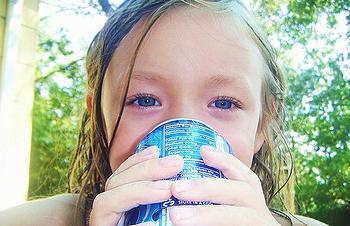NEW YORK, New York, September 18, 2012 (ENS) â€" Obese children and teens have higher levels of the chemical bisphenol A in their urine, researchers at New York University School of Medicine have found.
The synthetic chemical has been banned by the U.S. Food and Drug Administration from sippy cups and baby bottles. Still, the chemical continues to be used as an internal coating for aluminum cans, such as those containing soda.
“To our knowledge, this is the first report of an association of an environmental chemical exposure with childhood obesity in a nationally representative sample,†the authors write.

Aluminum drink cans are lined with bisphenol A. (Photo by Sasha)
“This is the first association of an environmental chemical in childhood obesity in a large, nationally representative sample,†said lead investigator Leonardo Trasande, MD, MPP, associate professor of pediatrics and environmental medicine.
“Our findings further demonstrate the need for a broader paradigm in the way we think about the obesity epidemic. Unhealthy diet and lack of physical activity certainly contribute to increased fat mass, but the story clearly doesn’t end there,†said Trasande.
Analysis showed the association between obesity and BPA urinary levels to be statistically significant in only one racial subpopulation, Caucasian children and adolescents.
The researchers found that obesity was not associated with exposure to other environmental phenols commonly used in other consumer products, such as sunscreens and soaps.
Bisphenol A, or BPA, is a low-grade estrogen that was until recently found in plastic bottles labeled with the number 7 recycling symbol, and is still used in aluminum drink cans.
Manufacturers say it provides an antiseptic function, but studies have shown the chemical disrupts multiple mechanisms of human metabolism that may increase body mass.
BPA exposure also has been associated with cardiovascular disease, breast cancer, prostate cancer, neurological disorders, diabetes and infertility.
The authors wrote, “In the U.S. population, exposure [to BPA] is nearly ubiquitous, with 92.6 percent of persons six years or older identified in the 2003-2004 National Health and Nutrition Examination Survey as having detectable BPA levels in their urine.â€
“A comprehensive, cross-sectional study of dust, indoor and outdoor air, and solid and liquid food in preschool-aged children suggested that dietary sources constitute 99 percent of BPA exposure,†the investigators wrote.
Using a sample of nearly 3,000 children and adolescents, ages six through 19 years, randomly selected for measurement of urinary BPA concentration in the 2003-2008 NHANES, Dr. Trasande and his co-authors, Jan Blustein, MD, PhD, and Teresa Attina, MD, PhD, MPH, examined associations between urinary BPA concentrations and body mass.
After controlling for race/ethnicity, age, caregiver education, poverty to income ratio, sex, serum cotinine level, caloric intake, television watching, and urinary creatinine level, the researchers found children with the highest levels of urinary BPA had 2.6 times higher odds of being obese than those with the lowest measures of urinary BPA.

Young soda drinker (Photo by Bella Catalina)
Among the participants with the highest levels, 22.3 percent were obese compared with 10.3 percent of the participants with the lowest levels.
“Most people agree the majority of BPA exposure in the United States comes from aluminum cans,†Dr. Trasande said. “This data adds to already existing concerns about BPA and further supports the call to limit exposure of BPA in this country, especially in children. Removing it from aluminum cans is probably one of the best ways we can limit exposure. There are alternatives that manufacturers can use to line aluminum cans.â€
The researchers wrote in their study that advocates and policy makers have long been concerned about BPA exposure.
“We note the recent FDA ban of BPA in baby bottles and sippy cups, yet our findings raise questions about exposure to BPA in consumer products used by older children,†they wrote.
Last year, the FDA declined to ban BPA in aluminum cans and other food packaging, announcing ‘reasonable steps to reduce human exposure to BPA in the human food supply’ and noting that it will continue to consider evidence on the safety of the chemical.
The study appears in the September 19 issue of “Journal of the American Medical Association,†which is dedicated to the theme of obesity.
Copyright Environment News Service (ENS) 2012. All rights reserved.

No comments:
Post a Comment